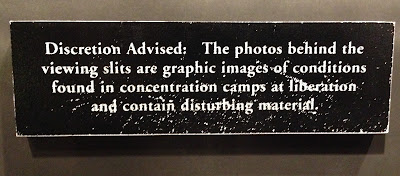THIS MUSEUM WAS REBUILT AND RENAMED. SEE NOV 2022.
12 Millstone
Campus
St. Louis. MO 63146
St. Louis. MO 63146
Admission and parking are free.
This excellent and very moving museum celebrated its
twentieth anniversary in August 2015. It is in the Kopolow Building, home of
the Jewish Federation of St. Louis. The
museum sits off of the main lobby.
We are so glad that we chose to do a free audio tour as
opposed to just walking through the displays. It is extremely well written and
is narrated by local television newsman Mike Bush with testimonies by Holocaust
survivors. You can use the audio device by holding it up to your ear or you can
also use headphones attached to it. There are 44 dialogues averaging 90
seconds. Throughout the museum you see
numbers on a silhouette that correspond with the dialogues; for example, below
is #19. Just follow the numbers.
Throughout
the museum you also see audio subject-specific snippets spoken by the “guides”,
local Holocaust survivors. There are
usually 3 or 4 grouped together on a red pentagon and you may listen to them at
your leisure.
There are also interspersed a few places where you can sit and watch a
short video.
The museum covers a very difficult subject without
overwhelming you with disturbing pictures. There are very few pictures
displayed of naked or dead bodies. There
are some hidden behind viewing slits and just a couple on display.
The displays are set up chronologically and take you through
adjoining rooms. Unfortunately the lighting in the museum rooms makes it very
difficult to get clear pictures from much of a distance.
The first room, The
Introductory Room, contains displays of photographs taken of Jewish
life in Europe prior to the Holocaust, each with a description that includes
who if anyone, in the picture survived.
These photographs were all donated by residents of St. Louis who survived or whose
family perished.
The second section is Jewish
Life Before Holocaust. The
picture below is part of a large display titled 1000 Years of Jewish History in Europe.
Possessions from the lives of European Jews are on display.
The display below from the third section The Rise of Nazism in Germany is
an example of some of the larger displays.
The display includes artifacts as seen below.
The fourth section is Early
World War II and the Beginning of the Holocaust. Below is an identity card issued to Felix
Levy in 1939 and also the cloth stars.
Below is a miniature of the Lodz Ghetto in Poland, second
largest ghetto in German-occupied Europe.
This section includes an entire wall with the chronological
history of Auschwitz and also a display of artifacts.
One can spend a lot of time studying this map, one of the displays
in The Holocaust and Final Solution,
the fifth section.
The sixth section is Liberation
and Rescue.
Jewish Life After
Holocaust is the last section.
These artifacts below all tell part of the story of the
journey to St. Louis by Holocaust survivors.
There is a final room called Change Begins with Me that is a learning center on how bias,
discrimination and genocide still exist today.
The notice below shows us that the museum is making changes
as new research is completed.
This map at the end of the tour is very sobering, as is, of
course, the entire tour.
This beautiful quilt was in the museum bookstore.
This beautiful artwork is at the entrance of the museum.
We found a great local deli at which to eat lunch after our
museum visit.
Pumpernickles Deli: http://www.pumpernickles.com/
This may be the best Reuben and Potato Salad I have ever
eaten. Outstanding!
Comments: This was a sobering but great museum. It is very well laid out and easy to follow. I have read and watched a great deal about
the Holocaust but still there was much here that was new to me.
The audio recording was excellent and I highly recommend
using it. If you have a large group and want a survivor to be present one needs
to contact the museum months in advance to make arrangements but honestly, the
museum did a fantastic job at including the survivors’ testimonies in the
displays and audio. It is worth taking
the time to push all the guide buttons and hear what they have to say. Don’t miss the three testimonies about the
forced marches. In fact, don’t miss any
of them.
We retired teachers did the entire audio tour, watched the
three videos, and listened to some of the guide testimonies and it took us
exactly two hours to complete. We did not read everything.
I have been to this museum twice and both times it was empty
which made it great for viewing.
However, I called ahead to confirm that no field trips or tour groups were
scheduled when I planned to go and I highly recommend you do that.
The museum relies on donations and consequently there is a
donation box at the end of the tour.
They
have an excellent website with information about hours, holidays, and special
events.

























































